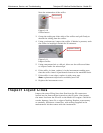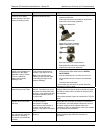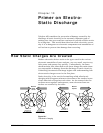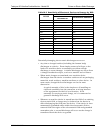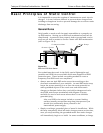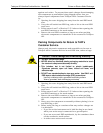
Primer on Electro-Static Discharge Teledyne API Ultrafine Particle Monitor - Model 651
94 07506C DCN6727
Common Myths About ESD Damage
• I didn’t feel a shock so there was no electro-static discharge:
The human nervous system isn’t able to feel a static discharge of
less than 3500 volts. Most devices are damaged by discharge
levels much lower than that.
• I didn’t touch it so there was no electro-static discharge:
Electro-static charges are fields whose lines of force can extend
several inches or sometimes even feet away from the surface
bearing the charge.
• It still works so there was no damage: Sometimes the damaged
caused by electro-static discharge can completely sever a circuit
trace causing the device to fail immediately. More likely, the
trace will be only partially occluded by the damage causing
degraded performance of the device or worse, weakening the
trace. This weakened circuit may seem to function fine for a
short time, but even the very low voltage and current levels of the
device’s normal operating levels will eat away at the defect over
time causing the device to fail well before its designed lifetime is
reached.
These latent failures are often the most costly since the
failure of the equipment in which the damaged device is
installed causes down time, lost data, lost productivity,
as well as possible failure and damage to other pieces of
equipment or property.
• Static Charges can’t build up on a conductive surface: There
are two errors in this statement.
Conductive devices can build static charges if they are
not grounded. The charge will be equalized across the
entire device, but without access to earth ground, they
are still trapped and can still build to high enough levels
to cause damage when they are discharged.
A charge can be induced onto the conductive surface
and/or discharge triggered in the presence of a charged
field such as a large static charge clinging to the surface
of a nylon jacket of someone walking up to a workbench.
• As long as my analyzer is properly installed, it is safe from
damage caused by static discharges: It is true that when
properly installed the chassis ground of your analyzer is tied to
earth ground and its electronic components are prevented from
building static electric charges themselves. This does not
prevent discharges from static fields built up on other things,
like you and your clothing, from discharging through the
instrument and damaging it.



